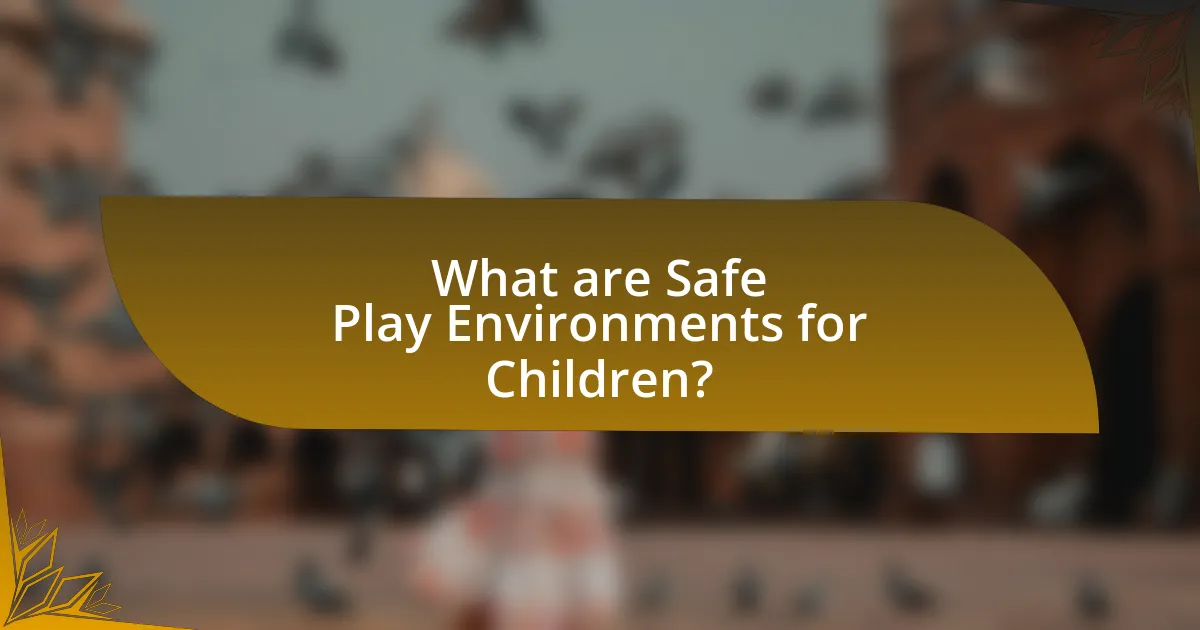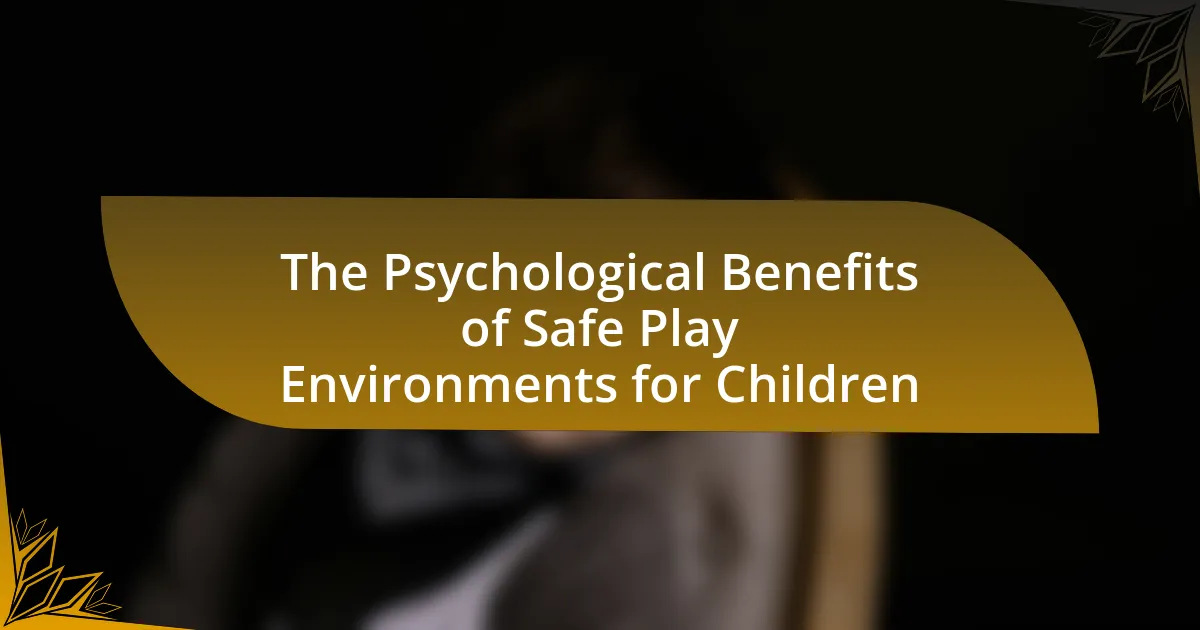Safe play environments for children are specifically designed spaces that prioritize their physical and emotional well-being during play. These environments feature safety measures such as soft surfaces, secure boundaries, and age-appropriate equipment, which significantly reduce the risk of injury and promote psychological health. Research indicates that children who engage in play within these safe environments experience lower levels of anxiety and stress, enhanced creativity, and improved social interactions. The article explores the defining characteristics of safe play environments, their impact on child development, and the psychological benefits they provide, including emotional well-being and social skill enhancement. Additionally, it discusses the importance of risk management, community involvement, and best practices for creating and maintaining these safe spaces.

What are Safe Play Environments for Children?
Safe play environments for children are designated spaces that prioritize the physical and emotional well-being of children during play. These environments are characterized by safety features such as soft surfaces, secure boundaries, and age-appropriate equipment, which reduce the risk of injury. Research indicates that children who engage in play within safe environments experience lower levels of stress and anxiety, promoting better psychological health. For instance, a study published in the Journal of Environmental Psychology found that children in well-designed play areas exhibit increased creativity and social interaction, highlighting the importance of safety in fostering positive developmental outcomes.
How do Safe Play Environments differ from traditional play areas?
Safe Play Environments differ from traditional play areas primarily in their design and safety features, which prioritize child well-being and risk mitigation. Safe Play Environments incorporate soft surfaces, age-appropriate equipment, and safety barriers to minimize injury risks, while traditional play areas may lack these considerations, often featuring hard surfaces and equipment that can lead to accidents. Research indicates that environments designed with safety in mind can enhance children’s confidence and encourage exploration, as evidenced by studies showing that children in safer play settings engage more freely in physical activities, leading to improved psychological outcomes such as reduced anxiety and increased social interaction.
What features define a Safe Play Environment?
A Safe Play Environment is characterized by several key features, including proper supervision, age-appropriate equipment, and a clean, hazard-free space. Proper supervision ensures that children are monitored to prevent accidents and injuries, while age-appropriate equipment minimizes risks associated with inappropriate use. A clean, hazard-free space eliminates dangers such as sharp objects or toxic substances, further enhancing safety. Research indicates that environments designed with these features significantly reduce the likelihood of injuries, thereby promoting psychological well-being and encouraging children to engage in play without fear.
Why is the design of play spaces important for safety?
The design of play spaces is crucial for safety because it directly influences the risk of injuries among children. Well-designed play areas incorporate safety features such as soft surfaces, proper spacing between equipment, and age-appropriate structures, which significantly reduce the likelihood of accidents. Research indicates that environments designed with safety in mind can lower injury rates by up to 50%, demonstrating the effectiveness of thoughtful design in mitigating hazards.
What role do Safe Play Environments play in child development?
Safe Play Environments significantly contribute to child development by providing a secure space for exploration and learning. These environments foster physical, social, and emotional growth, allowing children to engage in play that enhances their motor skills, creativity, and problem-solving abilities. Research indicates that children who play in safe environments exhibit lower levels of anxiety and higher levels of self-esteem, as they feel secure enough to take risks and interact with peers. For instance, a study published in the Journal of Environmental Psychology found that children in well-designed play areas showed improved social interactions and cooperative play, which are crucial for developing social skills.
How do these environments support physical development?
Safe play environments support physical development by providing children with opportunities for active engagement and movement. These environments, such as parks and playgrounds, are designed to encourage physical activities like climbing, running, and jumping, which enhance motor skills and coordination. Research indicates that children who have access to safe play areas are more likely to engage in regular physical activity, leading to improved strength, balance, and overall fitness. For instance, a study published in the “International Journal of Behavioral Nutrition and Physical Activity” found that children with access to well-maintained playgrounds participated in 25% more physical activity compared to those without such access. This evidence underscores the critical role that safe play environments play in fostering physical development in children.
What impact do they have on social skills?
Safe play environments significantly enhance children’s social skills by providing opportunities for interaction, cooperation, and conflict resolution. These environments encourage children to engage in group activities, fostering communication and teamwork. Research indicates that children who participate in structured play settings develop better social competencies, such as empathy and sharing, compared to those in less interactive environments. A study published in the Journal of Child Psychology and Psychiatry found that children exposed to safe, collaborative play settings showed improved social behaviors and reduced aggression, highlighting the positive correlation between safe play and social skill development.

What are the Psychological Benefits of Safe Play Environments?
Safe play environments provide significant psychological benefits for children, including enhanced emotional well-being, improved social skills, and increased confidence. These environments allow children to explore, take risks, and engage in imaginative play, which fosters creativity and problem-solving abilities. Research indicates that children who play in safe environments experience lower levels of anxiety and stress, as they feel secure and supported. A study published in the Journal of Environmental Psychology found that children who have access to safe play areas exhibit higher levels of happiness and social interaction, reinforcing the importance of safety in play for healthy psychological development.
How do Safe Play Environments contribute to emotional well-being?
Safe play environments significantly contribute to emotional well-being by providing children with a secure space to explore, socialize, and express themselves. These environments reduce anxiety and fear, allowing children to engage in play without the threat of harm or bullying. Research indicates that children who play in safe environments exhibit higher levels of self-esteem and emotional resilience, as they can freely interact with peers and develop social skills. For instance, a study published in the Journal of Environmental Psychology found that children in well-designed play areas showed improved mood and reduced stress levels, highlighting the direct link between safety in play and emotional health.
What specific emotions are positively influenced by safe play?
Safe play positively influences emotions such as joy, confidence, and security. Joy arises from engaging in enjoyable activities without fear of injury, fostering a sense of happiness. Confidence develops as children explore and master new skills in a safe environment, leading to increased self-esteem. Security is established when children feel protected, allowing them to express themselves freely and build trust in their surroundings. Research indicates that safe play environments contribute to emotional well-being by promoting these positive feelings, ultimately enhancing children’s overall development.
How does safety in play reduce anxiety in children?
Safety in play reduces anxiety in children by providing a secure environment where they can explore and express themselves without fear of harm. When children feel safe, they are more likely to engage in play, which fosters creativity and social interaction, both of which are essential for emotional development. Research indicates that safe play environments allow children to develop coping skills and resilience, as they can navigate challenges in a controlled setting. For instance, a study published in the Journal of Child Psychology and Psychiatry found that children who participated in structured play in safe environments exhibited lower levels of anxiety and improved emotional regulation compared to those in less secure settings. This evidence supports the notion that safety in play is crucial for reducing anxiety and promoting overall psychological well-being in children.
Why is risk management important in play environments?
Risk management is important in play environments because it ensures the safety and well-being of children while they engage in play activities. By identifying potential hazards and implementing strategies to mitigate risks, caregivers and facility operators can create a safer space that promotes healthy exploration and development. Research indicates that safe play environments contribute to children’s psychological well-being by reducing anxiety and fostering confidence, allowing them to engage more freely in social interactions and physical activities. For instance, a study published in the “International Journal of Environmental Research and Public Health” highlights that well-managed play areas significantly decrease the likelihood of injuries, thereby enhancing children’s overall play experience and mental health.
How does appropriate risk-taking benefit psychological growth?
Appropriate risk-taking enhances psychological growth by fostering resilience and self-efficacy in individuals. Engaging in manageable risks allows individuals, particularly children, to confront challenges, learn from failures, and develop coping strategies. Research indicates that children who participate in risk-taking activities, such as climbing or exploring new environments, demonstrate improved problem-solving skills and increased confidence. A study published in the Journal of Adventure Education and Outdoor Learning found that children who engaged in risk-taking play exhibited greater emotional regulation and social skills, reinforcing the notion that such experiences are crucial for healthy psychological development.
What balance should be struck between safety and challenge?
A balance between safety and challenge should prioritize children’s well-being while promoting their developmental growth. Safe play environments must minimize risks of injury, ensuring that children can explore and engage without significant harm. However, incorporating manageable challenges is essential for fostering resilience, problem-solving skills, and confidence. Research indicates that environments offering a mix of safety and challenge lead to better psychological outcomes, as children learn to navigate risks and develop coping strategies. For instance, a study published in the Journal of Adventure Education and Outdoor Learning found that children who engage in risk-taking play exhibit higher levels of self-esteem and social skills. Thus, the optimal balance involves creating spaces that are secure yet stimulating, allowing children to thrive both emotionally and socially.

How can caregivers and educators promote Safe Play Environments?
Caregivers and educators can promote safe play environments by implementing structured supervision, ensuring age-appropriate equipment, and fostering open communication about safety rules. Structured supervision allows caregivers to monitor children’s activities closely, reducing the risk of accidents. Age-appropriate equipment, such as soft play areas for younger children, minimizes injury potential. Additionally, fostering open communication about safety rules encourages children to understand and adhere to guidelines, which has been shown to enhance their sense of security and well-being. Research indicates that children who play in safe environments experience lower levels of anxiety and higher levels of confidence, supporting their psychological development.
What strategies can be implemented to enhance safety in play?
To enhance safety in play, implementing strategies such as regular safety audits, proper supervision, and the use of age-appropriate equipment is essential. Regular safety audits identify potential hazards in play areas, ensuring that equipment is well-maintained and safe for use. Proper supervision by adults or trained staff can significantly reduce the risk of accidents, as they can monitor children’s activities and intervene when necessary. Additionally, using age-appropriate equipment minimizes the risk of injury, as it is designed to meet the developmental needs and safety requirements of specific age groups. Research indicates that safe play environments contribute to children’s psychological well-being by allowing them to explore and engage in play without fear of injury, thus fostering confidence and social skills.
How can community involvement improve play safety?
Community involvement can significantly improve play safety by fostering a collaborative environment where local stakeholders actively participate in the maintenance and oversight of play areas. Engaged community members can identify potential hazards, advocate for necessary improvements, and ensure that play spaces are regularly inspected and maintained. Research indicates that neighborhoods with active community engagement report lower injury rates in playgrounds, as seen in a study published in the Journal of Safety Research, which found that community-led initiatives reduced accidents by 30% in local parks. This involvement not only enhances physical safety but also promotes a sense of ownership and responsibility among residents, further contributing to safer play environments for children.
What role do policies and regulations play in ensuring safe play?
Policies and regulations are essential in ensuring safe play by establishing standards and guidelines that protect children from hazards. These frameworks mandate safety measures such as proper equipment maintenance, age-appropriate play areas, and supervision requirements, which collectively reduce the risk of injuries. For instance, the U.S. Consumer Product Safety Commission provides guidelines that help playground designers and operators create safer environments, leading to a significant decrease in playground-related injuries. By enforcing these regulations, authorities can promote safer play experiences, ultimately supporting children’s psychological well-being through secure and enjoyable play environments.
What are best practices for creating Safe Play Environments?
Best practices for creating safe play environments include ensuring proper supervision, using age-appropriate equipment, and maintaining clean and hazard-free spaces. Proper supervision by adults reduces the risk of accidents and injuries, as studies show that children are less likely to engage in risky behavior when monitored. Age-appropriate equipment, such as swings and slides designed for specific age groups, minimizes the likelihood of injuries; the American Academy of Pediatrics emphasizes that equipment should match children’s developmental stages. Additionally, maintaining clean and hazard-free spaces, including regular inspections for broken equipment and removing potential dangers like sharp objects, is crucial for safety. These practices collectively contribute to a secure environment that fosters healthy psychological development in children.
How can caregivers assess the safety of play areas?
Caregivers can assess the safety of play areas by conducting thorough inspections for hazards, ensuring equipment is age-appropriate, and verifying that surfaces are soft and well-maintained. Regular checks for broken or damaged equipment, sharp edges, and potential tripping hazards are essential for identifying risks. According to the American Academy of Pediatrics, safe play environments significantly reduce the likelihood of injuries, which supports children’s psychological well-being by allowing them to explore freely without fear of harm. Additionally, caregivers should ensure that play areas are enclosed and supervised to prevent accidents and promote a secure environment for children.
What resources are available for designing safe play spaces?
Resources available for designing safe play spaces include guidelines from organizations such as the American Society for Testing and Materials (ASTM) and the Consumer Product Safety Commission (CPSC), which provide safety standards for playground equipment and surfacing materials. Additionally, the National Program for Playground Safety offers resources and training for creating safe play environments. Research indicates that well-designed play spaces can significantly reduce the risk of injuries, with studies showing that adherence to safety standards can lower injury rates by up to 50%.
What are common challenges in maintaining Safe Play Environments?
Common challenges in maintaining safe play environments include inadequate supervision, insufficient safety equipment, and environmental hazards. Inadequate supervision can lead to accidents, as children may engage in risky behaviors without adult oversight. Insufficient safety equipment, such as soft surfaces under play structures, increases the risk of injury during falls. Environmental hazards, like broken equipment or unsafe landscaping, can pose significant dangers to children. According to the National Program for Playground Safety, approximately 200,000 children are treated in emergency rooms each year for playground-related injuries, highlighting the critical need for effective maintenance and safety measures in play environments.
How can funding issues affect the safety of play areas?
Funding issues can significantly compromise the safety of play areas by limiting maintenance, repairs, and upgrades. Insufficient financial resources often lead to delayed inspections and the inability to replace damaged equipment, which increases the risk of accidents. For instance, a study by the National Program for Playground Safety indicates that poorly maintained play structures are associated with a higher incidence of injuries among children. Additionally, lack of funding can prevent the installation of safety features such as soft surfacing, which is crucial for reducing fall-related injuries. Therefore, inadequate funding directly correlates with heightened safety risks in play environments, ultimately affecting children’s well-being and psychological benefits derived from safe play.
What are the barriers to implementing safety measures in play environments?
Barriers to implementing safety measures in play environments include financial constraints, lack of awareness, and regulatory challenges. Financial constraints often limit the resources available for upgrading equipment and maintaining safety standards, as many organizations prioritize budget allocations for other needs. Lack of awareness among stakeholders, including parents and community leaders, can lead to insufficient advocacy for safety improvements. Regulatory challenges arise from complex compliance requirements that can deter organizations from pursuing necessary safety upgrades. For instance, a study by the American Academy of Pediatrics highlights that inadequate funding and knowledge gaps significantly hinder the adoption of safety protocols in playgrounds, emphasizing the need for targeted interventions to overcome these barriers.
What practical tips can be applied to ensure Safe Play Environments?
To ensure safe play environments, implement regular safety inspections and maintenance of play equipment. Regular inspections help identify hazards such as broken equipment or unsafe surfaces, which can prevent injuries. According to the U.S. Consumer Product Safety Commission, approximately 200,000 children are treated in emergency rooms for playground-related injuries each year, highlighting the importance of maintaining safe conditions. Additionally, providing adequate supervision during playtime ensures that children are monitored for risky behaviors, further enhancing safety. Establishing clear safety rules and educating children about them fosters a culture of safety, reducing the likelihood of accidents.
